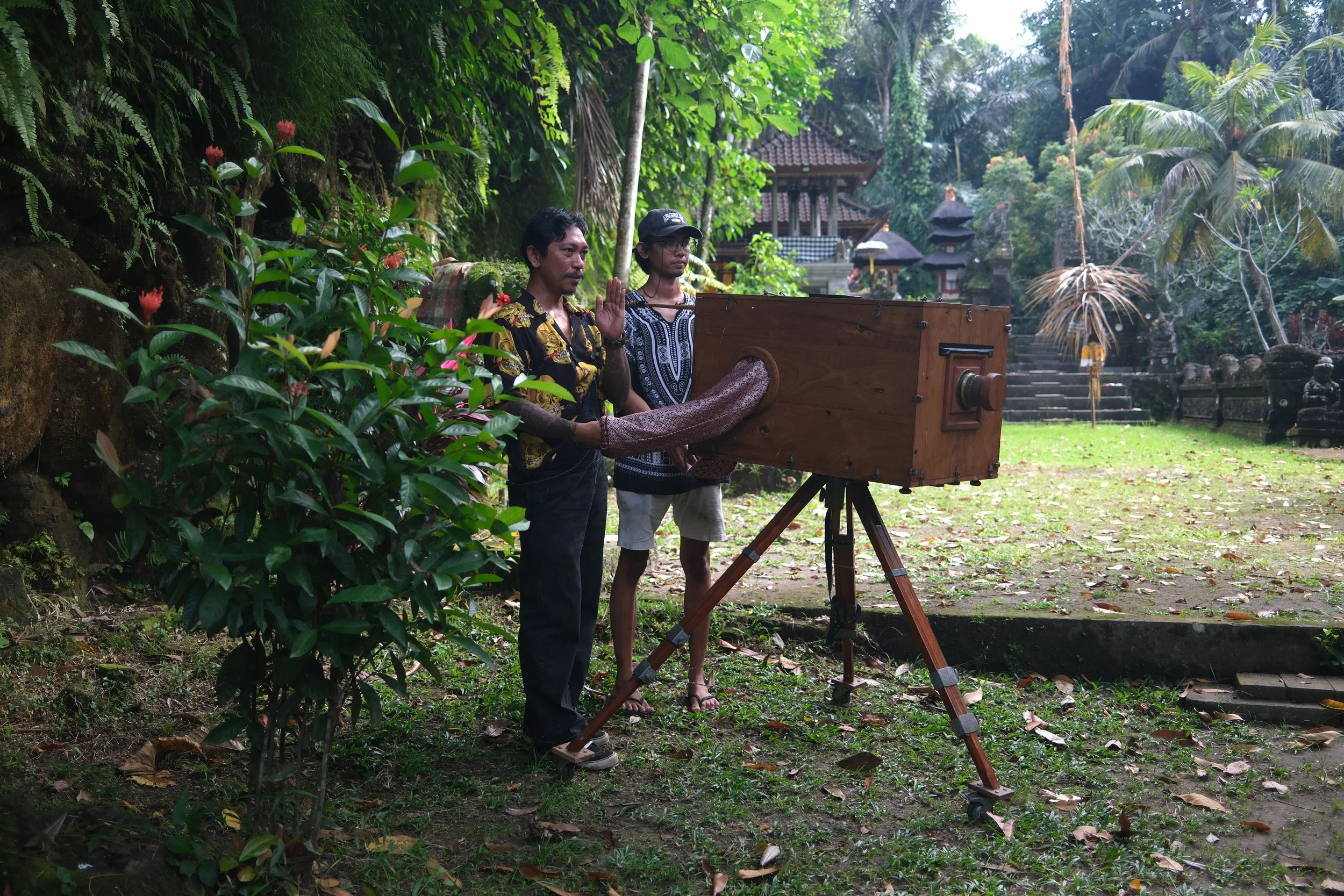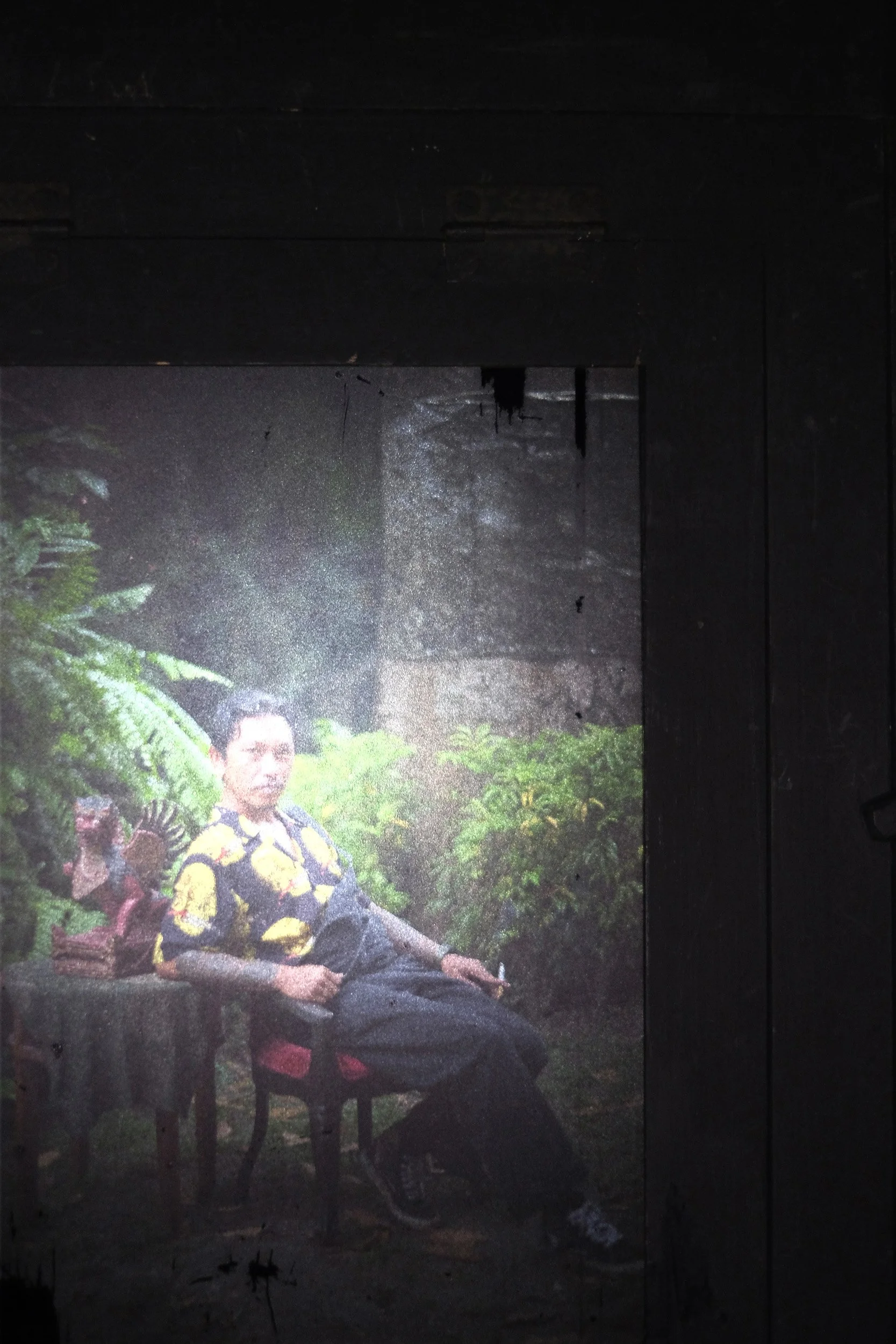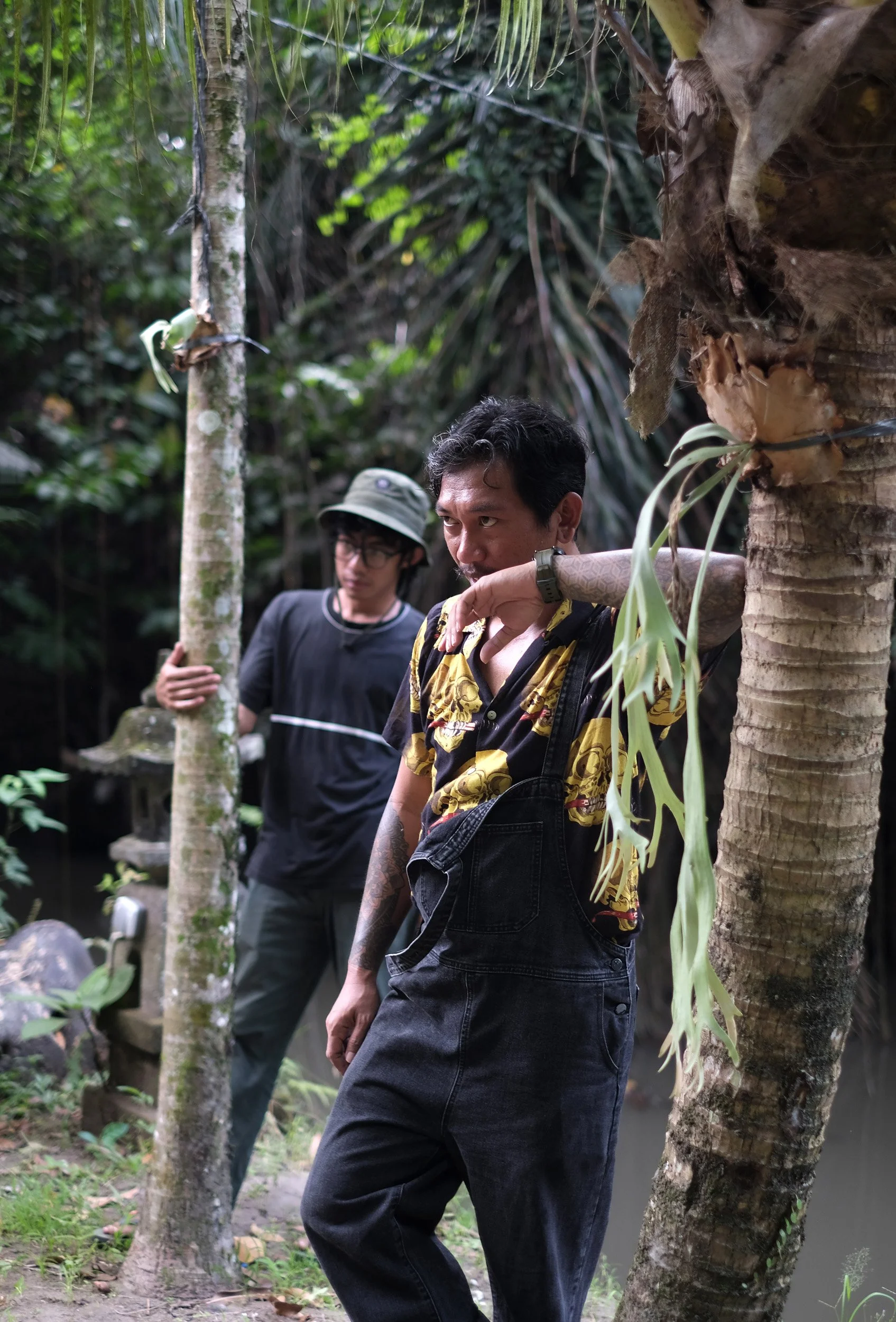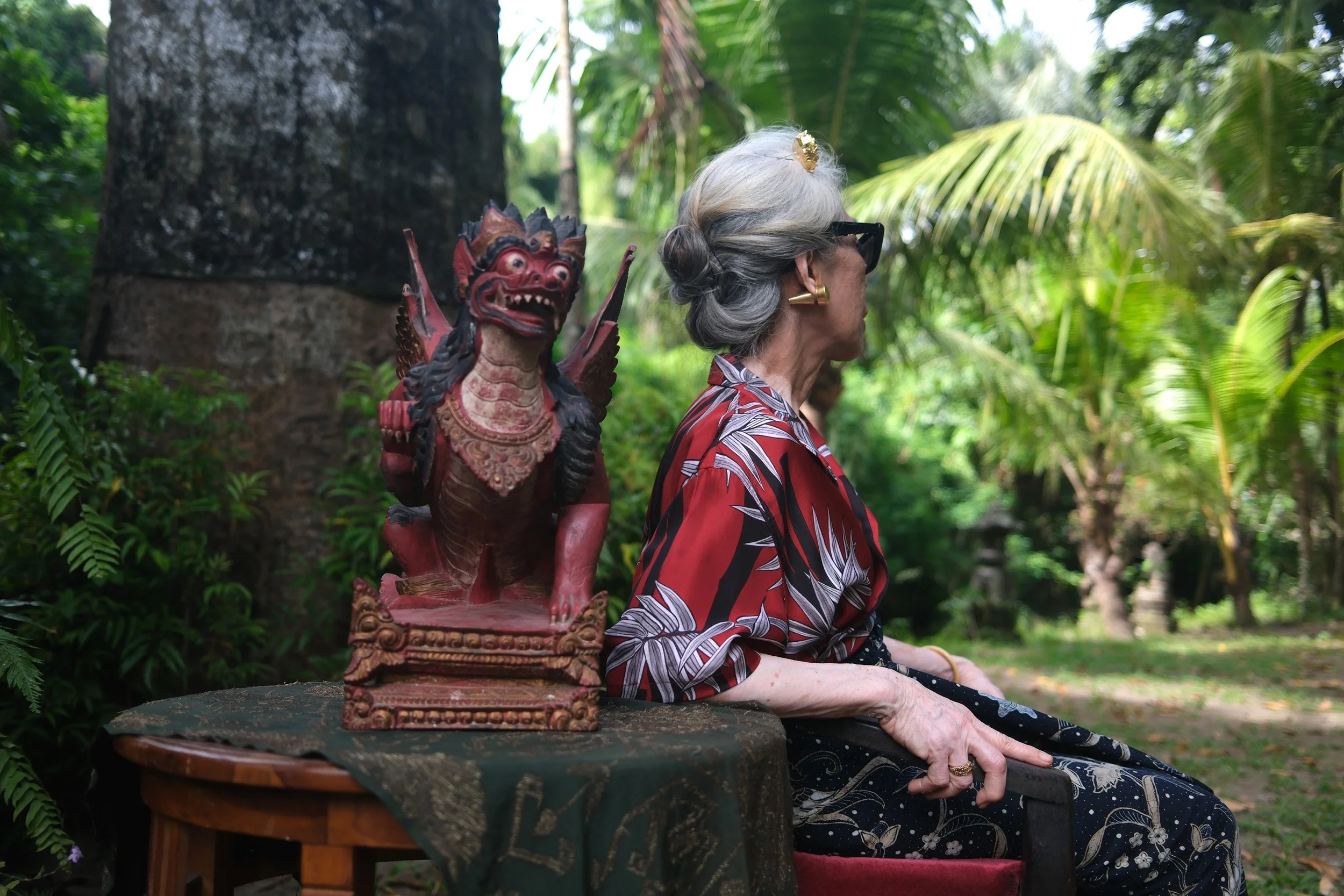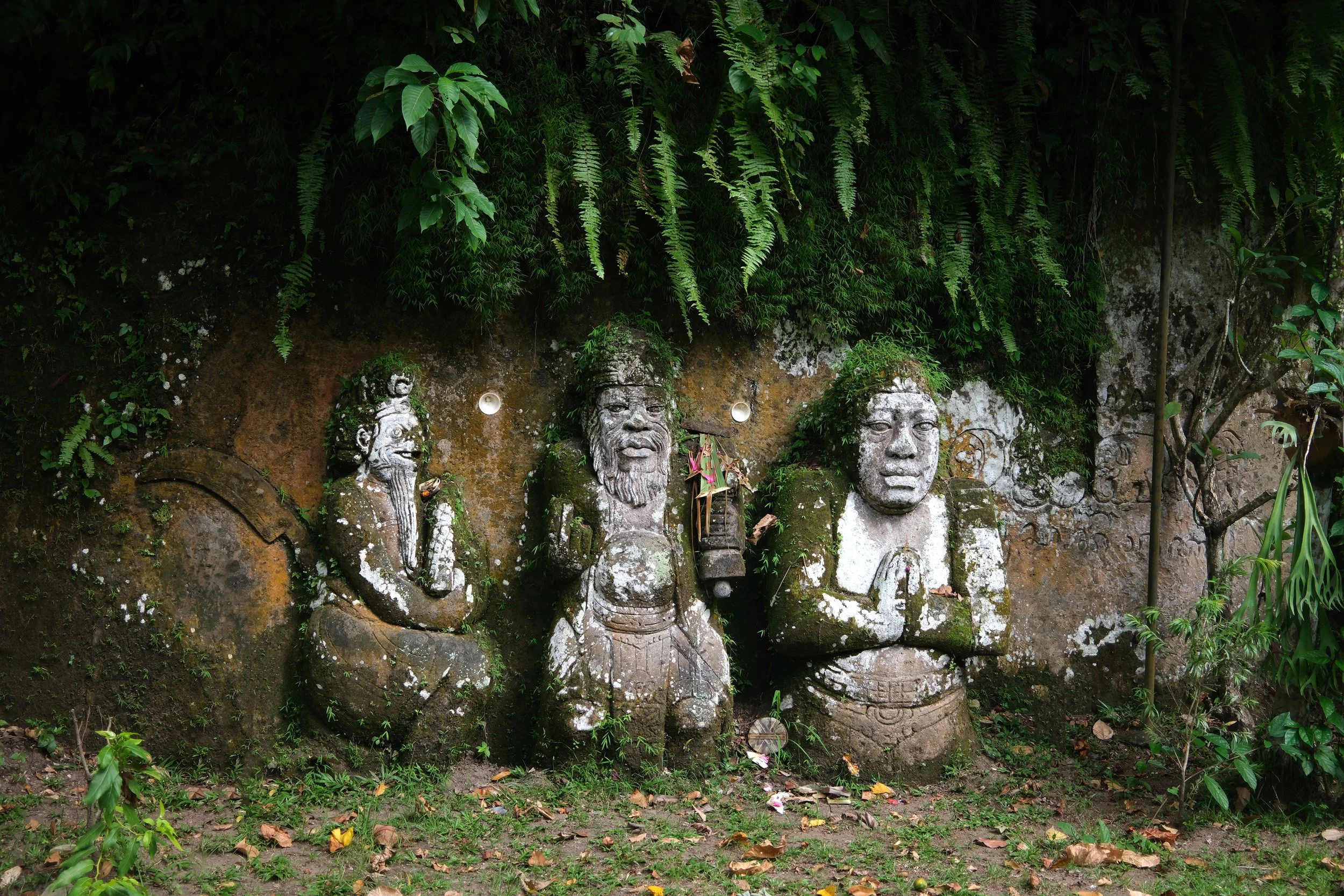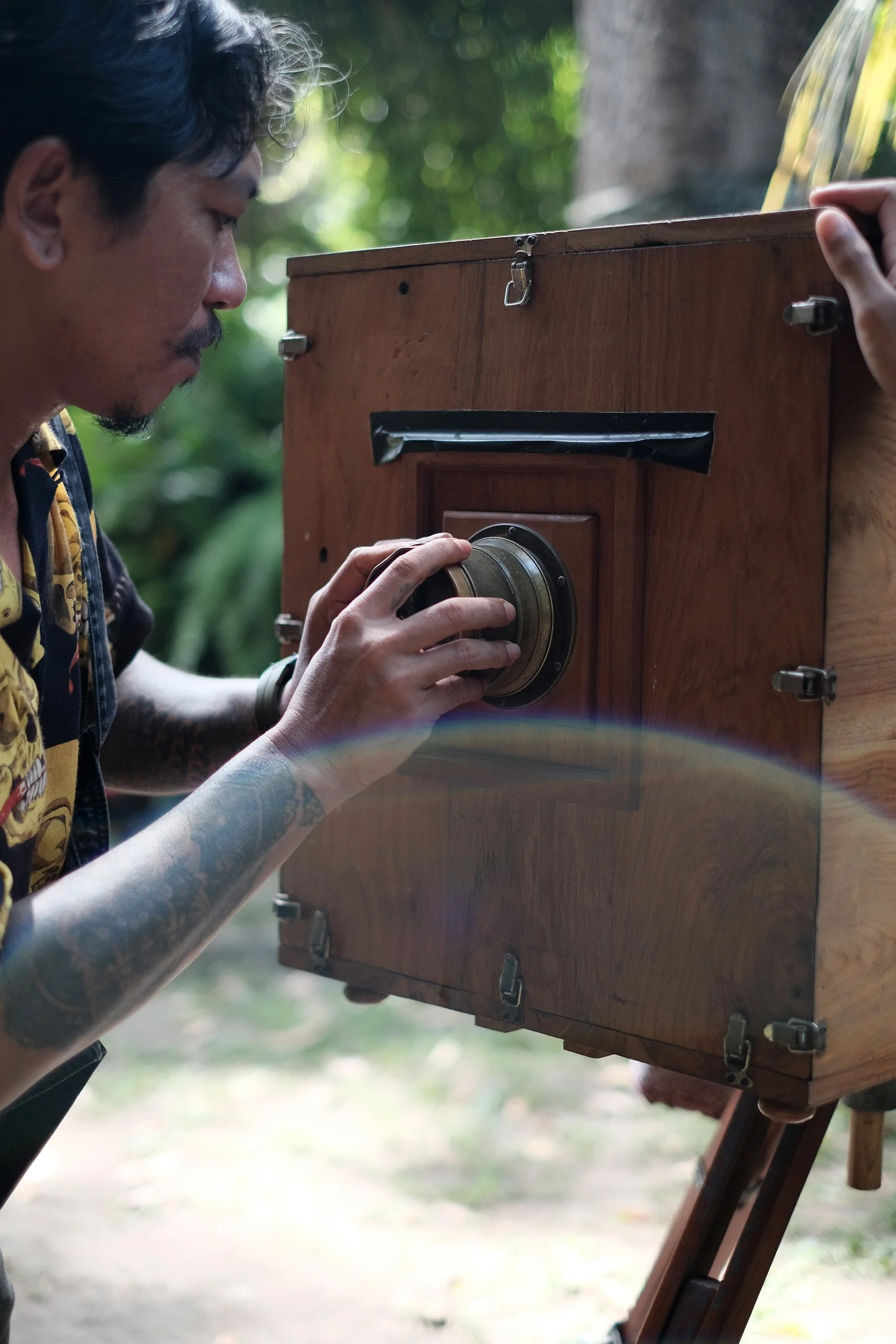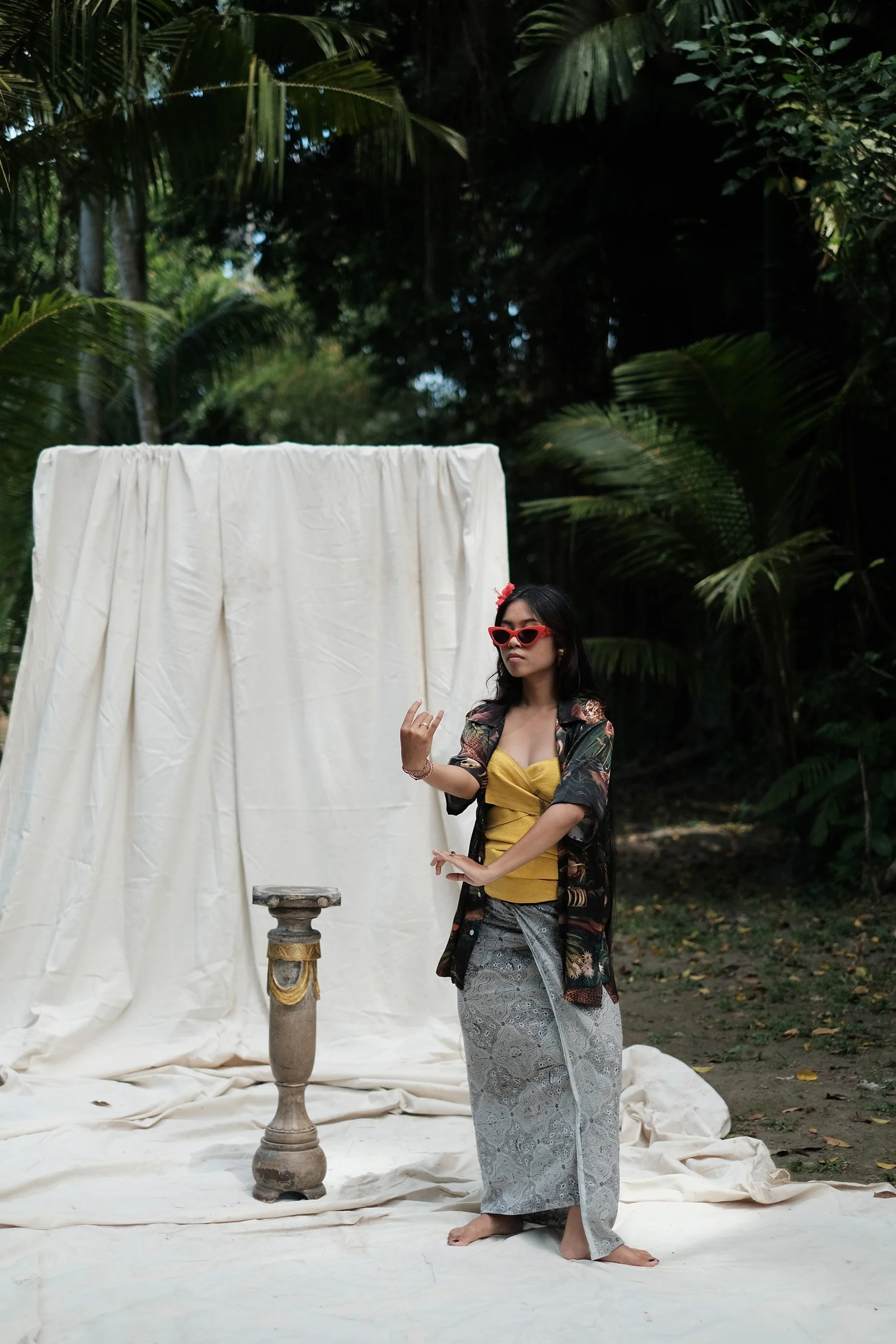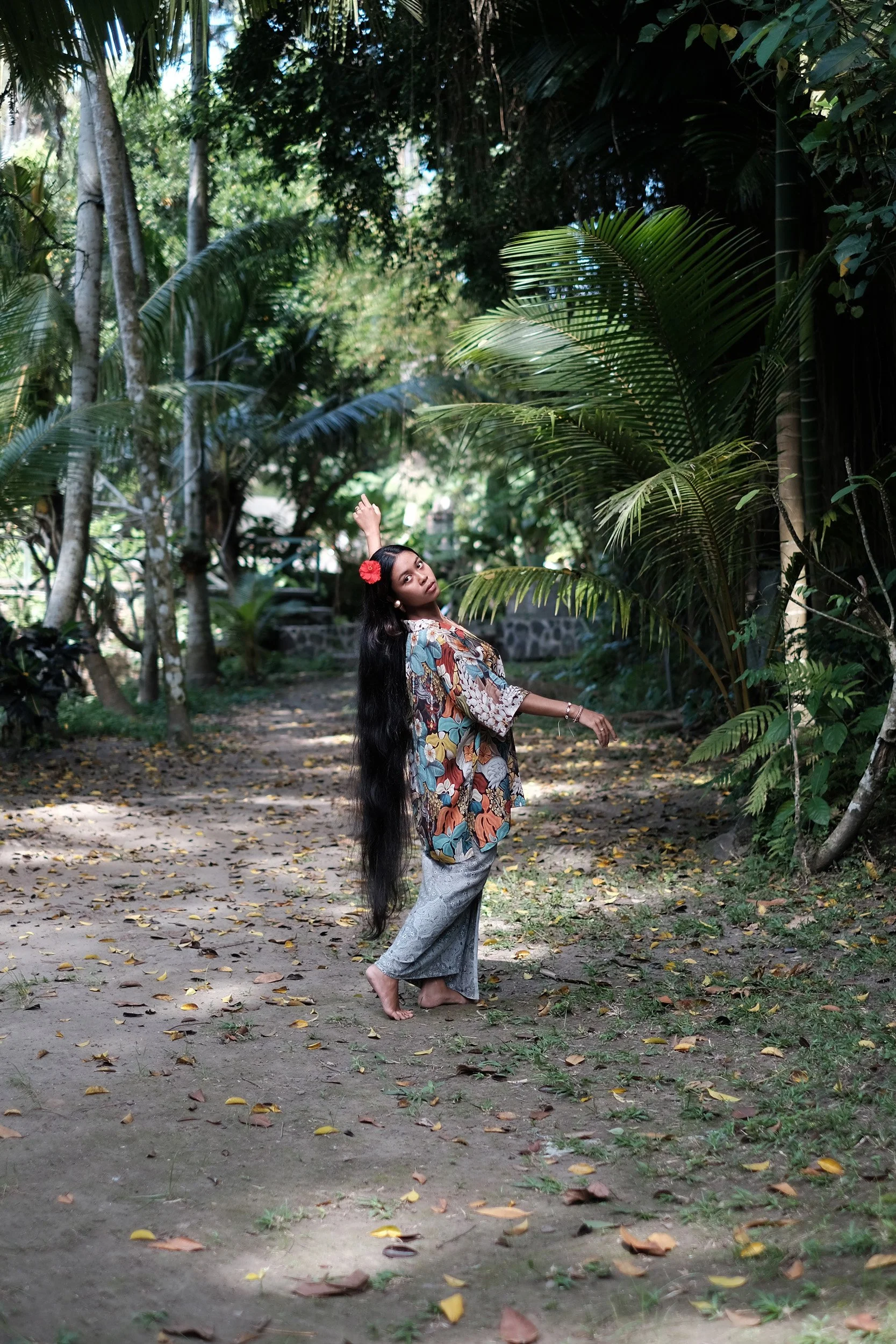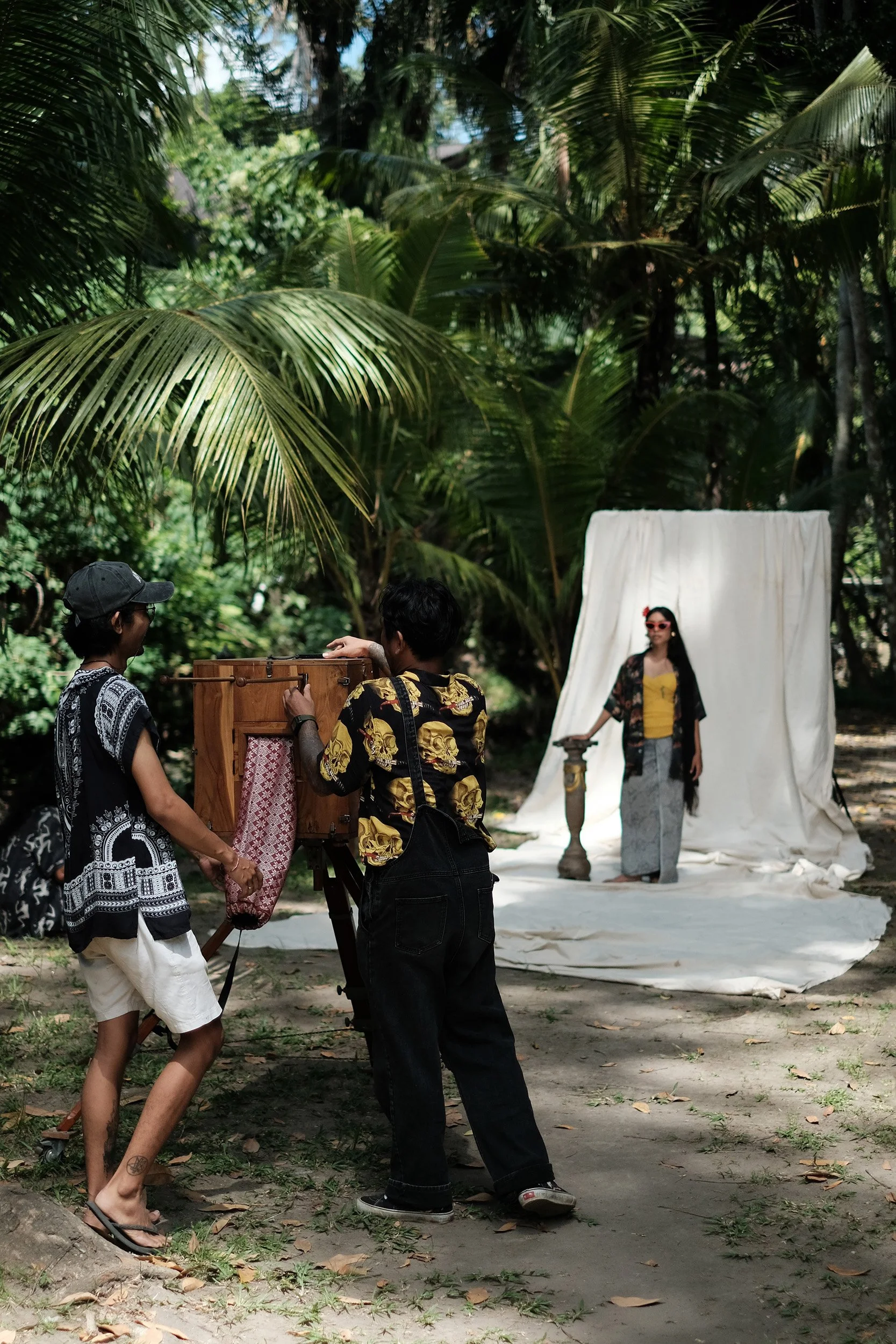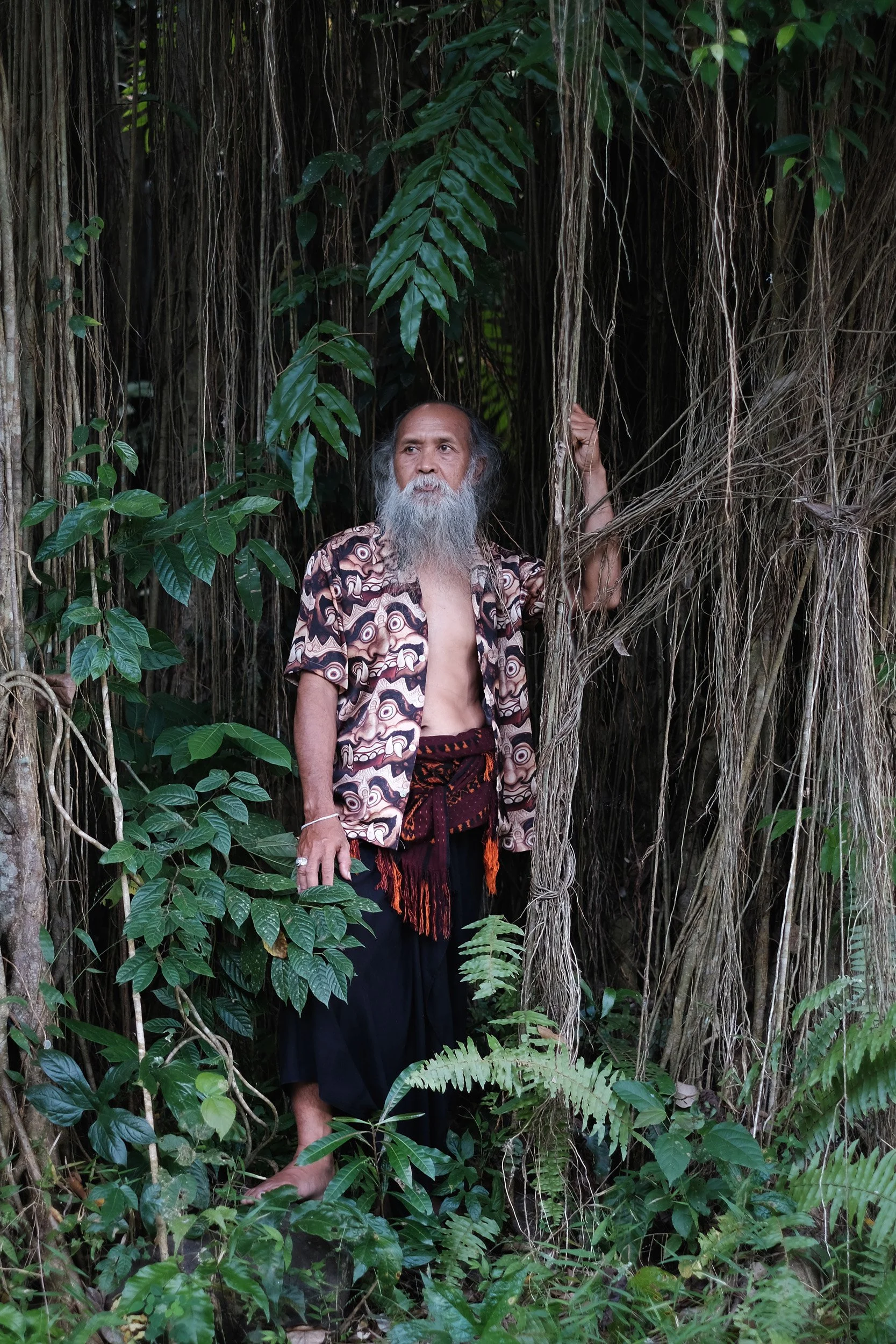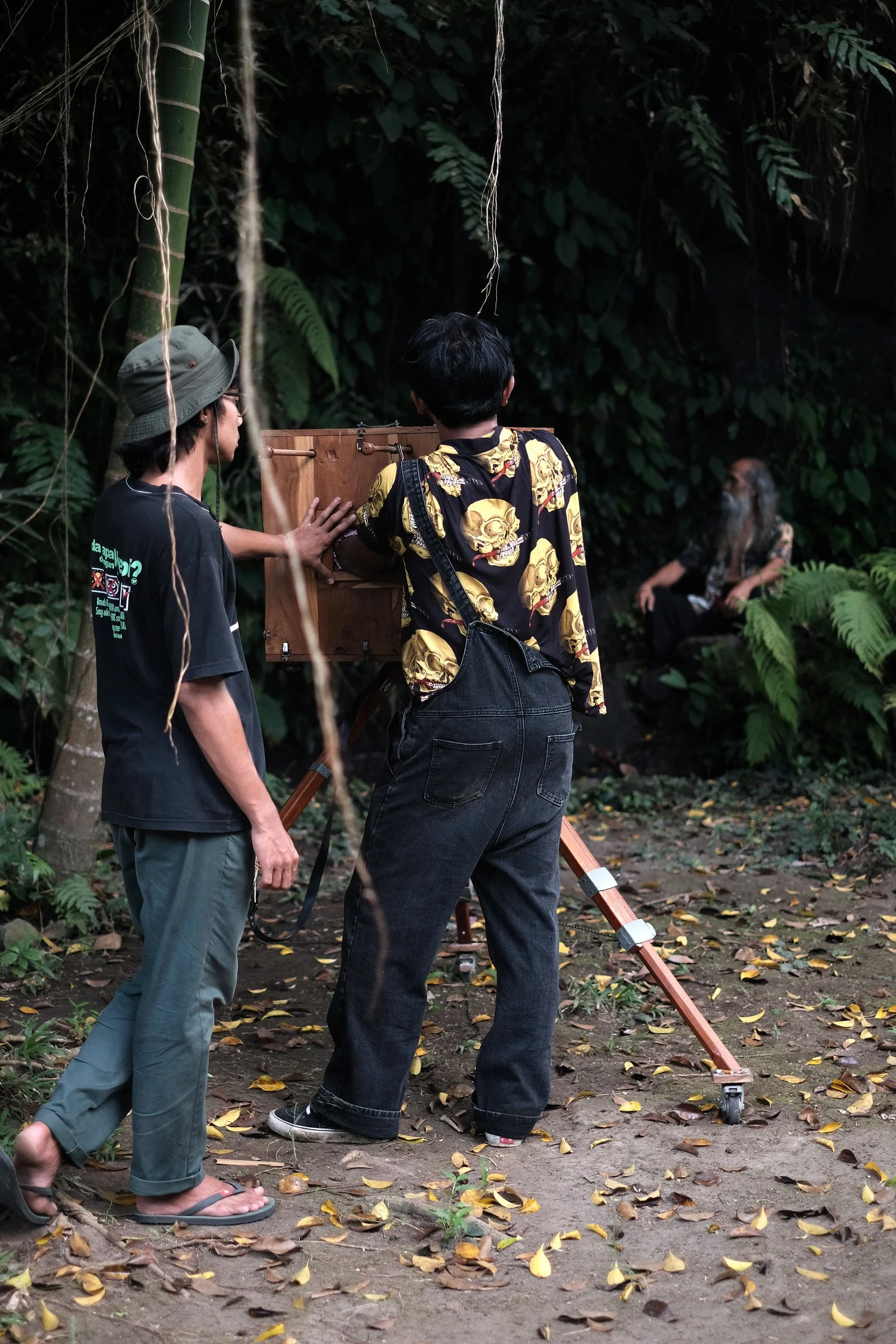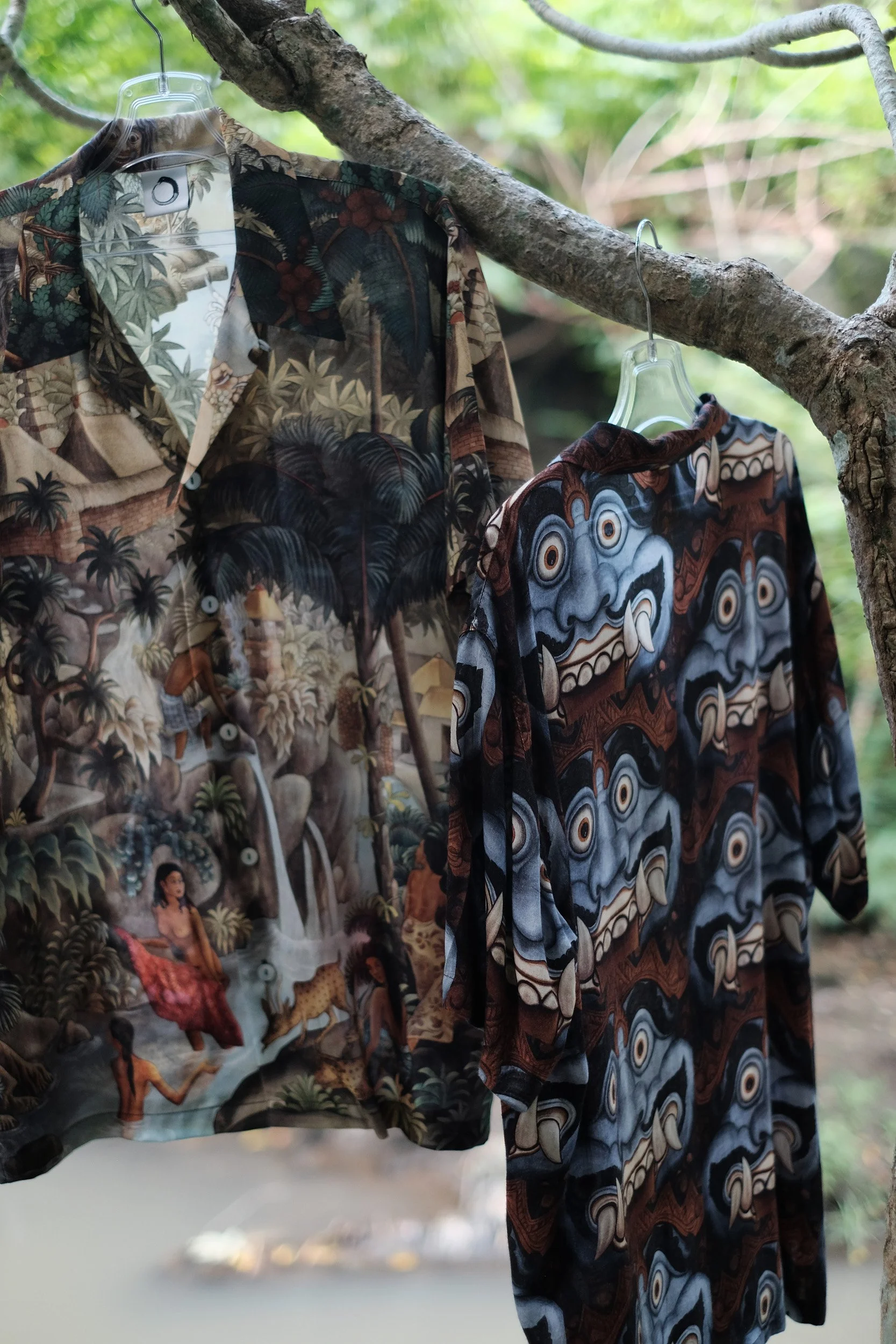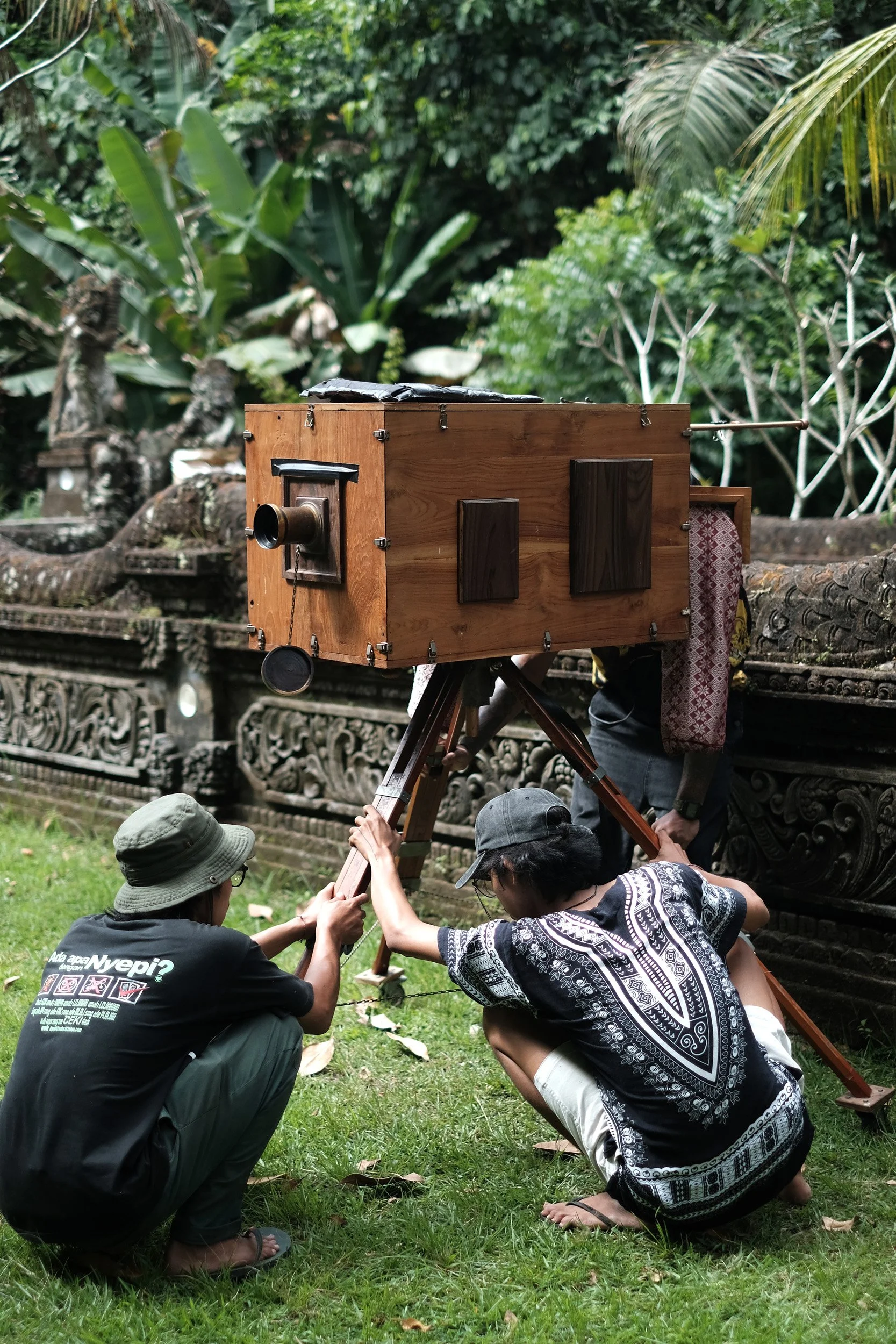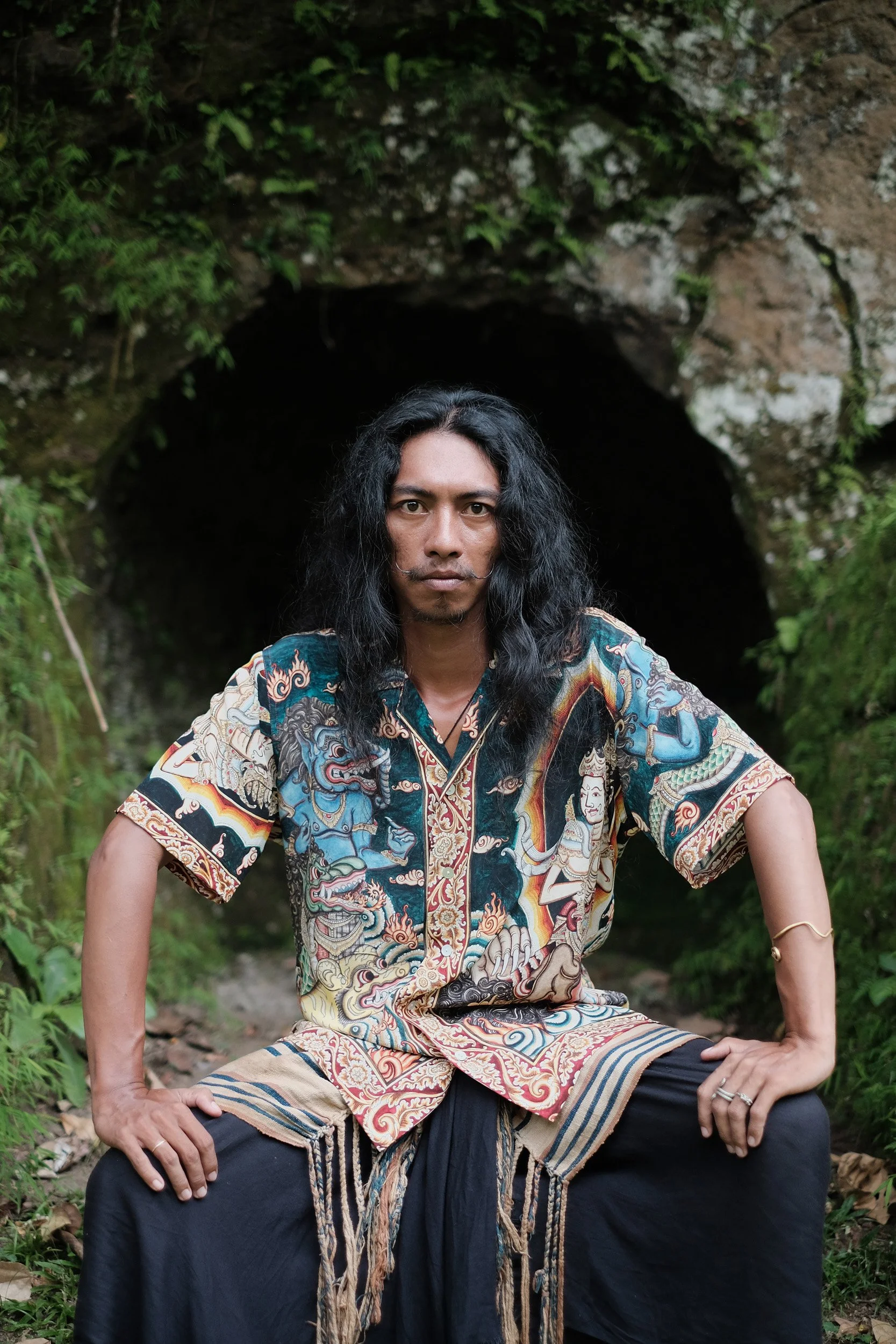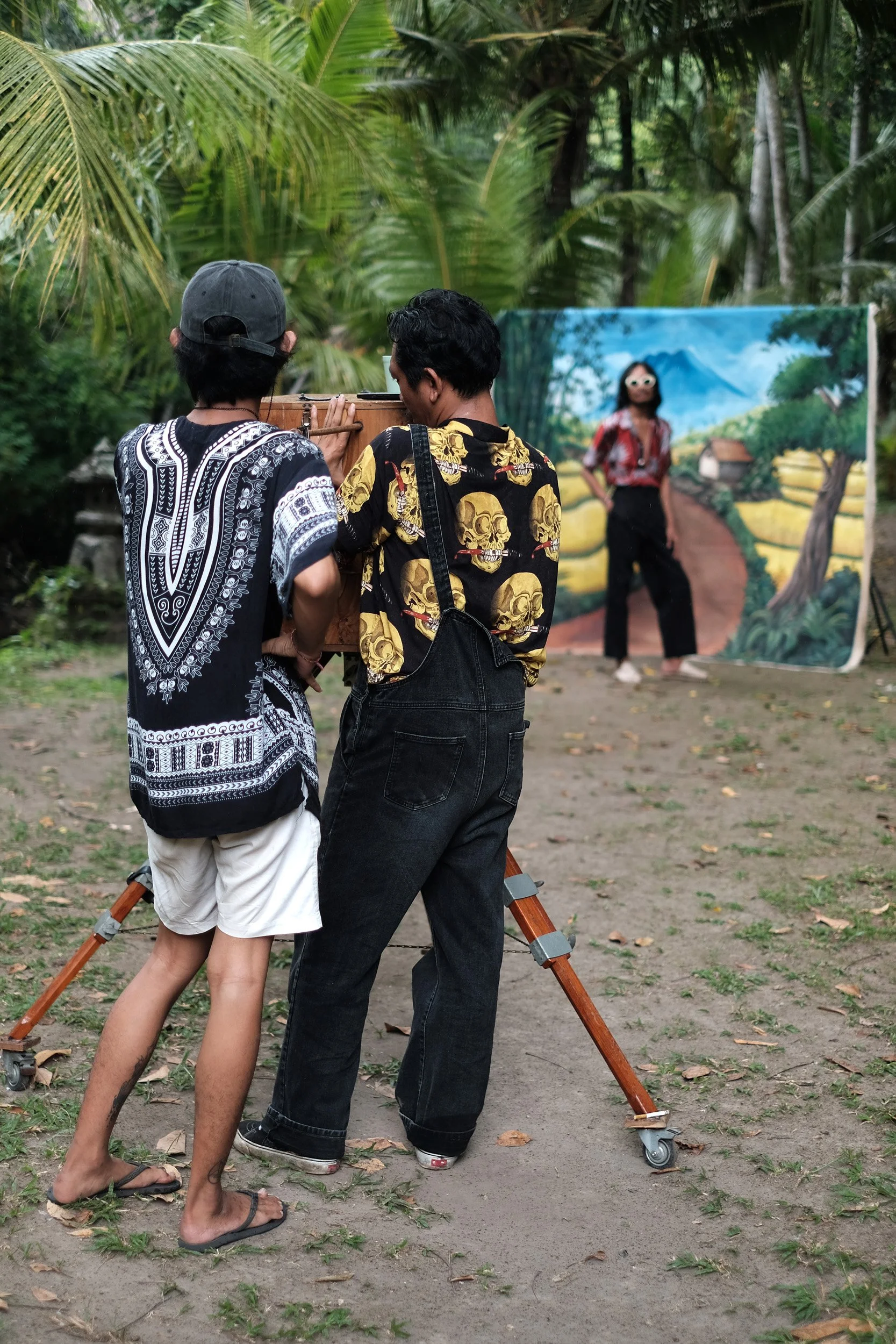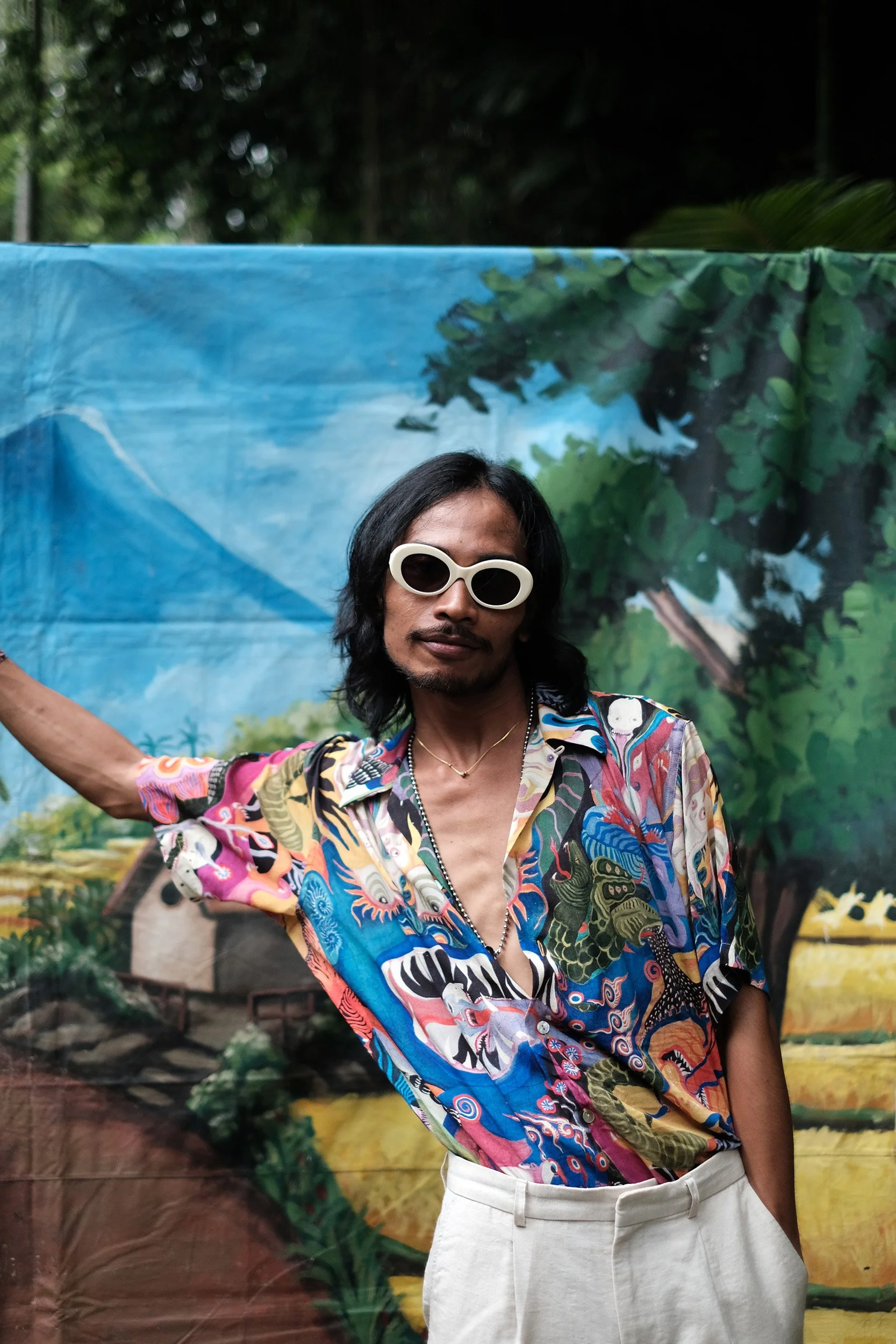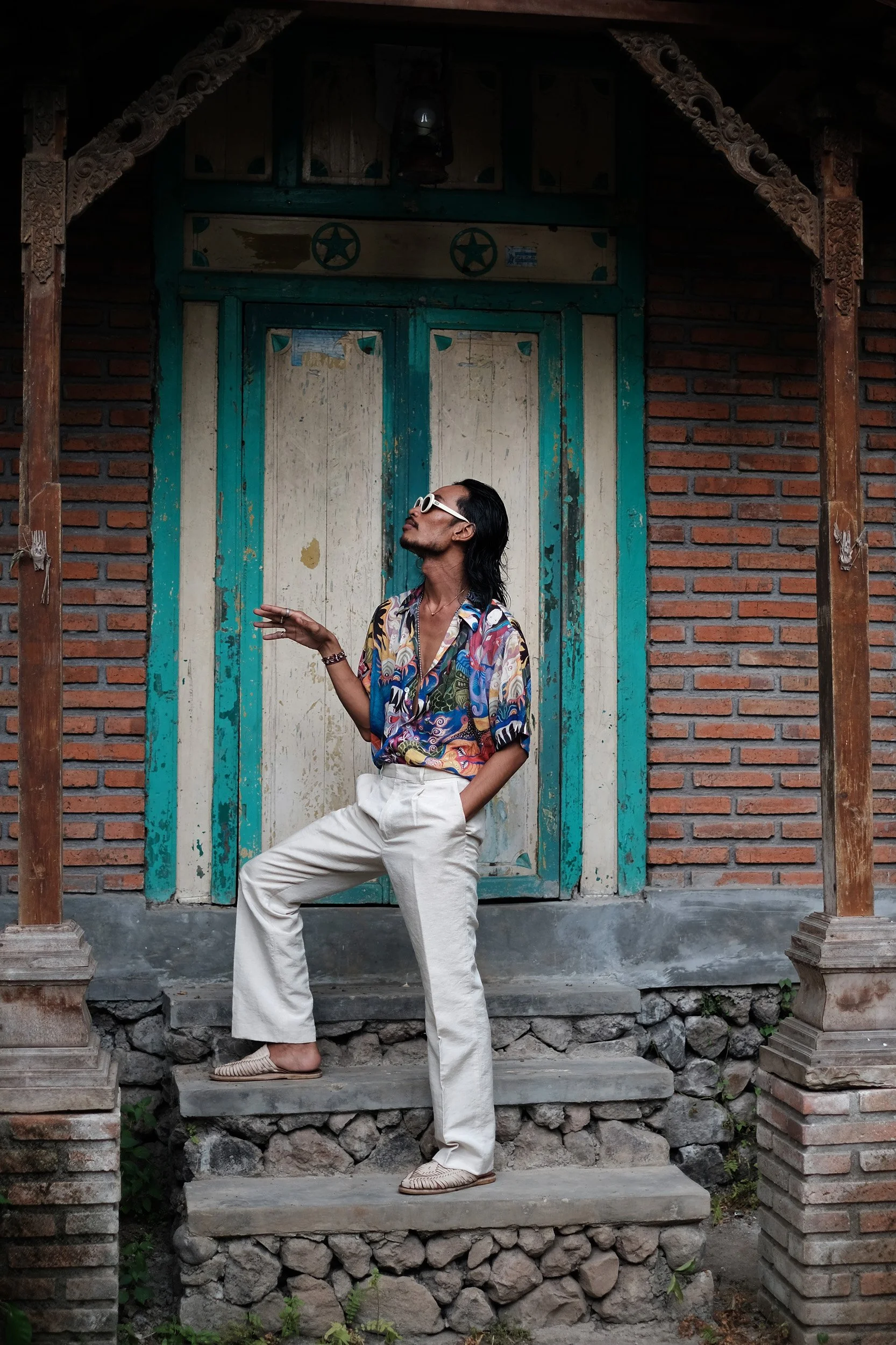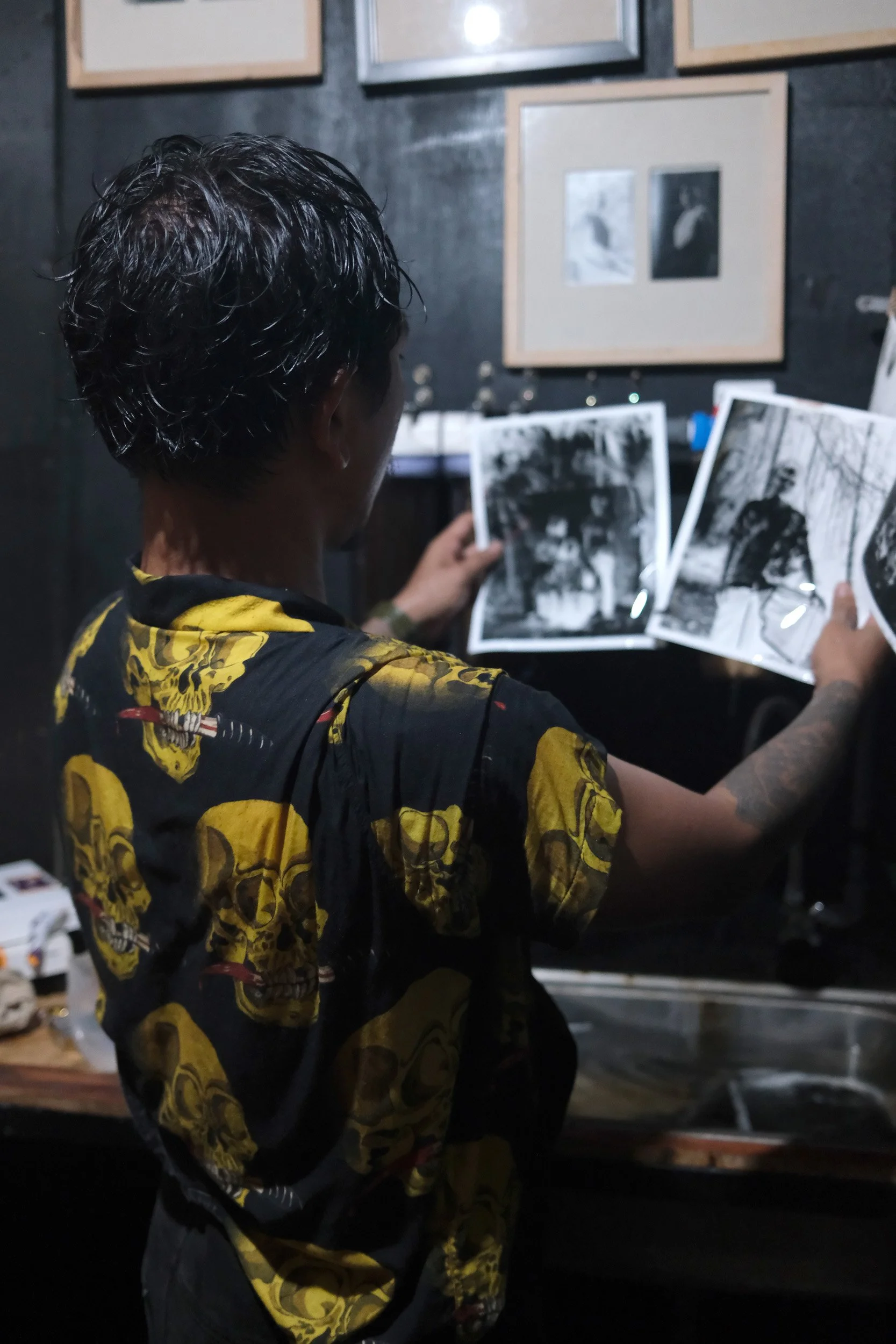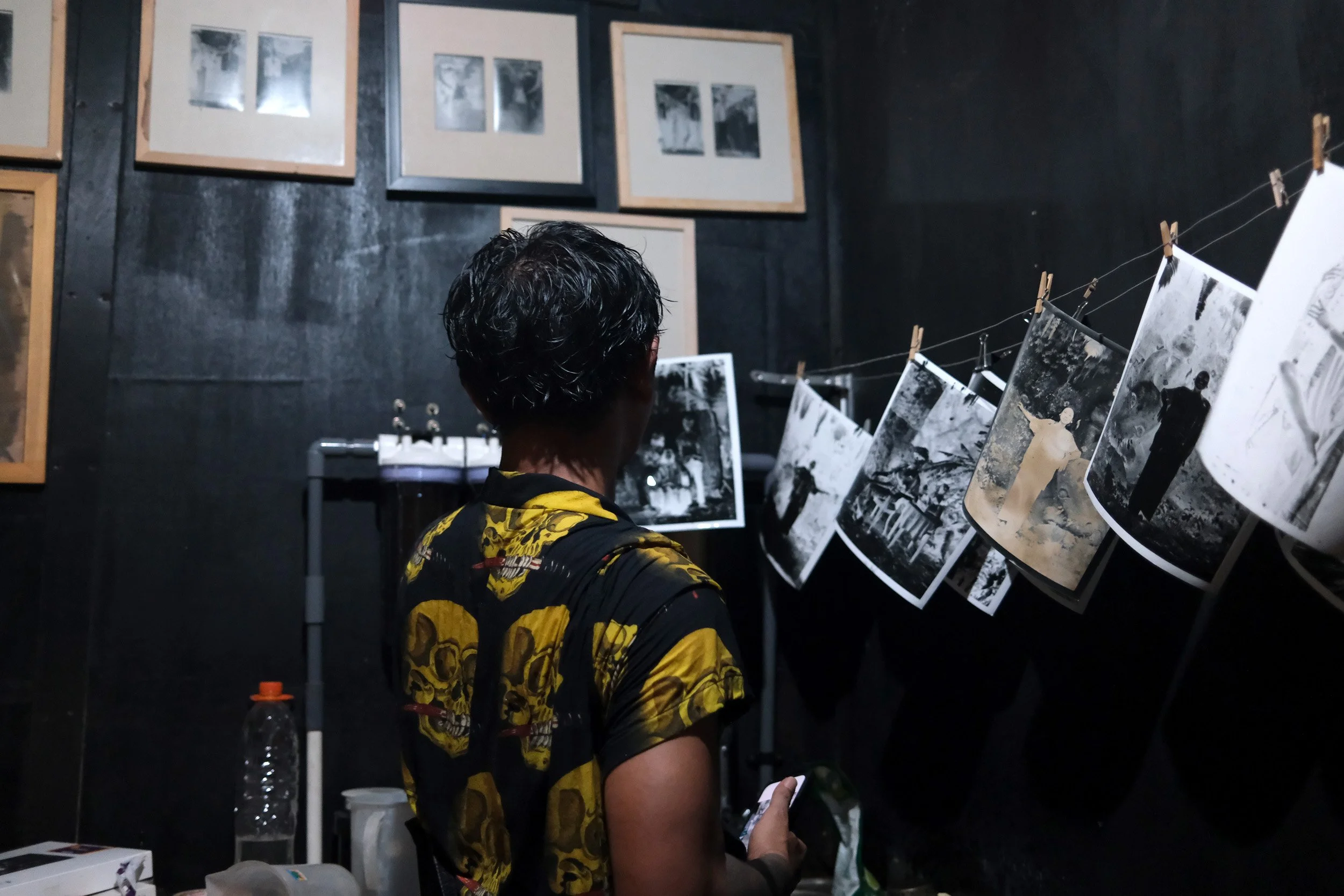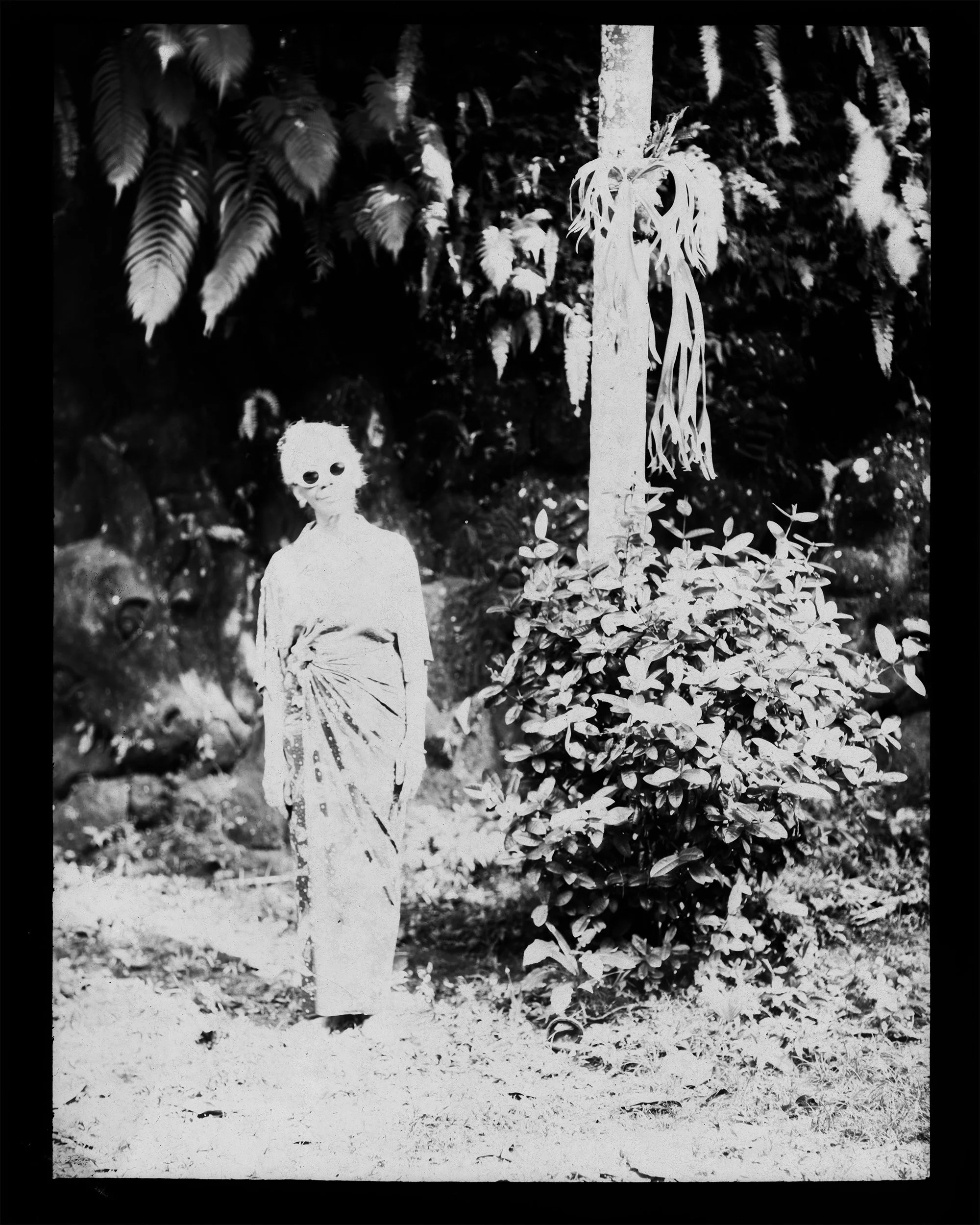GUNG AMA: SEARCHING FOR TAKSU
We arrive early, just as the morning light spills across the rice fields outside Ubud. The air is soft, the road winding us deeper into the jungle—to Tegal Temu Space, the creative sanctuary of Balinese artist and myth-weaver Gung Ama.
Gung Ama is no ordinary photographer. He works with an Afghan box camera he built by hand—an analog portal in a digital world. But the camera is only part of the story. In Bali, there’s a word for what his work holds: taksu. It’s not just talent—it’s a sacred force. A presence. A spiritual charisma that breathes through the artist and their creation. You can’t fake it. You feel it, or you don’t.
At Tegal Temu Space, you feel it immediately.
We’re here as part of a collaboration with Endless Joy—to capture and celebrate five Balinese individuals who embody this rare, radiant energy. As we wander through gardens and cross bridges shaded by ancient trees, we meet dancers, priests, musicians, and seekers—each one a living expression of their craft. Their presence, like Gung Ama’s, pulses with depth, warmth, and unforced grace.
This isn’t about performance. It’s about living art.
Gung Ama himself moves between worlds with quiet intensity—smoking, smiling, building, listening. His box camera stands in the jungle like a relic from another dimension: giant, wooden, brassed with time, its painted backdrop of rice terraces and volcanoes blending seamlessly with the real landscape beyond.
What happens here is hard to describe and impossible to replicate. There’s no ego, no pretension. Just presence. Just people deeply engaged in the act of creation—not for an audience, but for the joy and reverence of it.
In conversation, Gung Ama shares what moves him—ancestral knowledge, the pulse of the forest, the aliveness of the land. His answers, like his photographs, invite us inward. They reveal how myth and memory merge, how art becomes both process and offering.
This is a glimpse into that world.
A dialogue between Endless Joy and Gung Ama—on vision, spirit, craft, and the enduring power of taksu.
Endless Joy:
What does the word “art” mean to you, and have you always considered yourself an artist? What’s your earliest memory of creating something that made you feel alive? Was there a moment when you knew art would be your path?
Gung Ama:
Art, to me, is an experience of feeling — it’s about how one can read not only from books, but from situations and phenomena around them, and then express that through a medium. Do I consider myself an artist? I believe “artist” is a title given by the people who experience the work. As for my first memory of creating something that made me feel alive — it was like falling in love. There’s a feeling that words cannot express. I simply walked the path sincerely, wanting only to stand on my own two feet. If that’s what you mean by “art,” then yes — I’m standing on the path of art.
Endless Joy:
You built your own camera — which is wild and beautiful. Before we dive into the technical, can you take us back to what first drew you to photography? Why images? Why this way of seeing?
Gung Ama:
I was born in an artistic village. Like most Balinese children, I was exposed early on to art — dance, percussion, sculpture. I chose photography when I entered university in 2006. That’s when I realized photography wasn’t just about taking pictures, but also about learning — socially, politically, historically, and beyond.
Endless Joy:
Do you work in other mediums too? How do they cross-pollinate with your photography?
Gung Ama:
Right now, I’m experimenting with collage — using recycled packaging and blending it with photographic elements.
Endless Joy:
Tell us about your Afghan box camera — did you really build it by hand? What inspired you to go that route?
Gung Ama:
The Afghan Box Camera, known as Kamra-e-Faoree, is a wooden instant camera still used in Afghanistan today. Its origins go back to William Henry Fox Talbot in 1841, whose calotype process allowed infinite reproductions and laid the groundwork for modern photography. Building one is really about constructing a light-tight box — not necessarily special in itself. What makes mine unique is the aesthetic value and the aged teak wood I chose. I also built it to be modular so it’s easier to transport for shoots outside the city.
Endless Joy:
What was the process of building it like — was it trial and error, or did you have a clear vision from the start?
Gung Ama:
Before building, I studied both the technical and historical aspects. I sketched out the design and made a cardboard prototype before crafting the final version from wood.
Endless Joy:
How is shooting with it different from a digital or film camera? Do you ever use modern gear? Or is the box camera your main vessel now? What draws you to shoot the way you do?
Gung Ama:
There’s a personal touch in the physical creation of each image. That tactile process lets me transfer energy and fully connect with the work. Yes, I still use modern gear for commercial or instant needs — like pre-wedding shoots. But the box camera is now my primary vessel for visuals rooted in collaboration or personal unease. I’m aware that not everyone who comes to me understands the feeling and process behind photography, but I stay true to it.
Endless Joy:
What is the core idea of your work? How much is shaped by your environment — the jungle, the light, the energy of the land? What’s your experience working in nature versus the studio?
Gung Ama:
History and ancestral wisdom are the foundation of everything I create. Every natural element — forest, light, earth’s energy — holds power. Collaborating with that energy teaches me something with each step and process.
Cromagnon shirt
Endless Joy:
Your work has a deep sense of time — ancient, almost mythic — yet it's also innovative. What is your relationship with the past? How does it guide your way forward?
Gung Ama:
Looking at the past is how I learn about Bali through the eyes of a Balinese person. As long as the past remains my focus, I’ll keep learning.
Endless Joy:
Balinese mythology, spirit, and ritual seem to breathe through your work. How do you approach capturing someone’s portrait? Is there a ritual or intention before the shutter clicks?
Gung Ama:
Prayer is born of honesty. When building a piece, I always make sure that every step is rooted in a process of sincerity.
Endless Joy:
What inspired you to create Tegal Temu, and what philosophy shapes its spirit? What happens there? Who comes through? What do you hope it gives back to the community?
Gung Ama:
I’ve been surrounded by kind people — people who gave me space to learn while I was discovering myself. “Tegal Temu” means “Meeting Garden.” I hope that what is planted here grows and one day, at harvest, we’ll enjoy it together in a gathering. This space is a living laboratory, powered by creativity and collective breath. Everyone who contributes here is family. We welcome all — across professions, generations, and backgrounds. Anyone who feels this is home.
Endless Joy:
If you had to distill your passion into three words, what would they be?
Gung Ama:
Aesthetics – Philosophy – Spirit
Endless Joy:
What are you working on right now? Anything that’s consuming your mind or keeping you up at night in a good way? And dreaming ahead — what would you love to create in the future?
Gung Ama:
I always struggle to answer what I’m working on. I just want to do things that are useful and meaningful to others — whether through visuals, stories, or my daily actions. My dream is to build a healthy space for the next generation to grow and learn — a school, a photography museum. I want to keep learning and educating those around me. But above all, I want to do it sincerely.
Endless Joy:
What does Bali mean to you — personally and creatively?
Gung Ama:
Bali is a mother. She gave me a place to grow and learn. Bali’s heritage is an endless well of knowledge.
Endless Joy:
What’s your view on the growing tension between tradition and modernity in Bali? What needs protecting, and how can creativity help?
Gung Ama:
Bali needs to see itself honestly — especially through government regulation. Modernization has created a crisis of self-confidence. Tourism and Western influence are slowly eroding our Eastern values. It has made Balinese people more instant-minded. We need to preserve the ancestral intelligence and reinterpret the concepts our ancestors created. Creativity can be an educational bridge — for both the public and the government.
Endless Joy:
How would you define Taksu? What does it feel like when it’s present in your work or a space like Tegal Temu? Do you feel the dynamic between subject, artist, and medium?
Gung Ama:
Taksu is energy born of understanding. Taksu is felt by those who experience my work or visit Tegal Temu. It’s a recognition — an energy others can sense. I absolutely feel the dynamic when the subject, artist, and medium understand each other. Without that understanding, Taksu doesn’t appear. It becomes ego instead.
Endless Joy:
“Myth — the gift that keeps giving.” What’s a myth or story that’s stayed with you — one you return to often?
Gung Ama:
I always return to myself. My story is an ongoing record of learning — one that never ends.
Endless Joy:
“The real sharpness is a celebration of the sharpness of mind, ideas, and the ability to use them shoulder to shoulder, in togetherness.” Can you share more on this idea of togetherness and collective creativity?
Gung Ama:
I’m aware that humans are social beings — we’re formed by communal concepts. Today, that awareness is fading, turning into individuality. I want to help Balinese people regain their confidence — to speak freely, without fear of being stabbed in the back.
Endless Joy:
What was it like to collaborate with Endless Joy? Did the art from Endless Joy influence the photographic process? What are your thoughts on the experience as a whole?
Gung Ama:
I’m proud and happy to collaborate with Endless Joy. Our views align — on energy, feeling, and how these can be fused to create Taksu. The experience overall was deeply meaningful.
